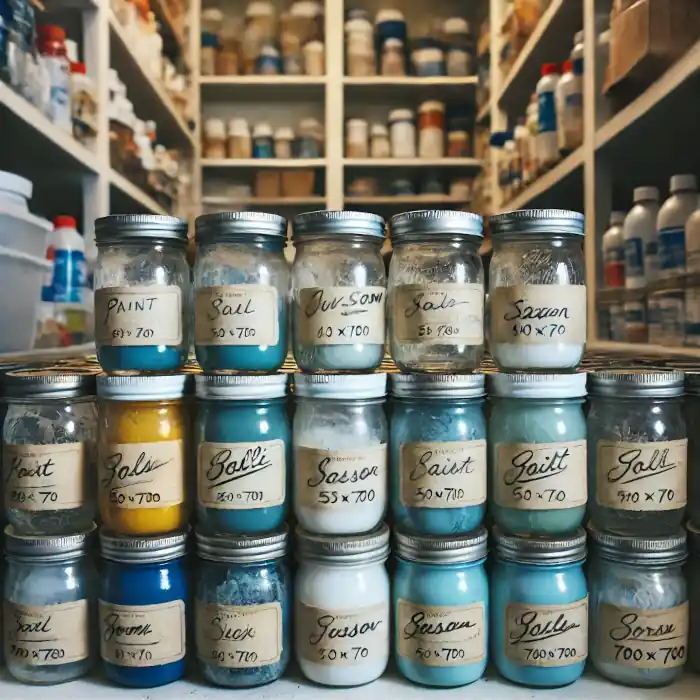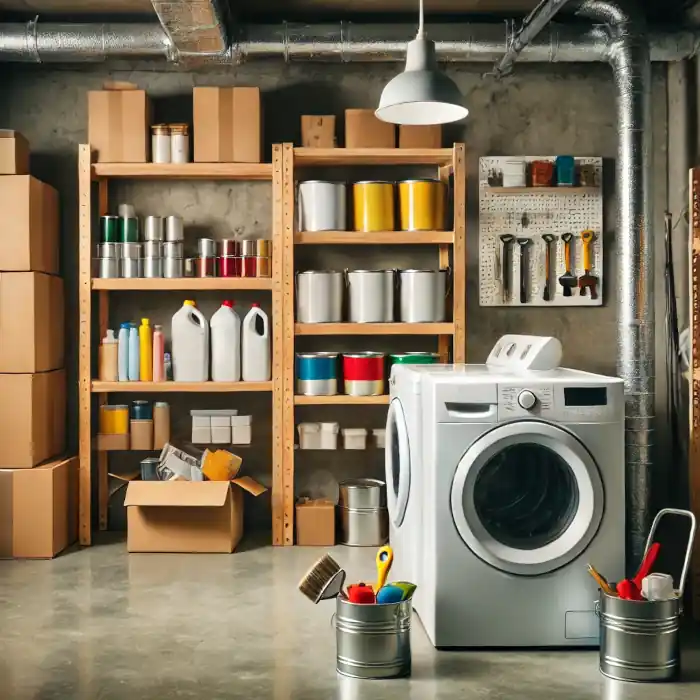As an Amazon Associate, I earn from qualifying purchases. Privacy Policy / Terms
Paint projects often come with a fair share of leftovers—no matter how precisely you measure the amount you think you will need, there is typically some paint left in the can. While it can be tempting to simply toss what remains, leftover paint has a multitude of future uses. You might want to do a few quick touch-ups down the road, paint a small craft project, or refresh a piece of furniture with a coordinating color. Storing leftover paint properly can save you time and money, and it’s also more environmentally responsible than disposing of perfectly good paint. However, if paint is not stored in the right conditions or containers, it can quickly degrade or become unusable. In this article, we’ll examine best practices and detailed guidelines on how to store leftover paint for future use while maintaining its quality over time.
Why Proper Storage Matters
Extending Shelf Life
Proper storage of paint can extend its shelf life significantly. In many cases, paint can remain usable for years if it is sealed well and kept under the right conditions. Conversely, if it is exposed to air, extreme temperatures, or moisture, the chemical composition can break down. This breakdown leads to clumping, separation, and mold or mildew growth. By storing paint correctly, you’re effectively prolonging its freshness.
Saving Time and Money
Paint is not necessarily inexpensive, especially if you’re using high-quality or specialty paints. Keeping leftovers in good condition means you can use them to touch up scuffs, scratches, or worn spots without having to buy a new batch. Over the long term, you save money on new paint purchases, and you save time by having to re-match colors. Proper storage also ensures color consistency; reusing the exact same paint helps avoid issues with color variance.
Environmental Responsibility
Leftover paint that goes bad or is improperly discarded can pose environmental hazards. Latex and acrylic paints contain chemicals that, when not disposed of correctly, can contaminate soil and water sources. Oil-based paints contain volatile organic compounds (VOCs) that are regulated in many regions. Properly storing leftovers means fewer cans of paint ending up in landfills and fewer harmful chemicals being released into the environment.
Types of Paint and Their Storage Needs
Water-Based (Latex or Acrylic) Paint
Water-based paints (often labeled latex or acrylic) are the most common household interior and exterior paints. They are generally easier to store because they are less flammable and contain fewer harmful solvents than oil-based paints. They typically have a lower VOC content, which makes them more environmentally friendly. However, water-based paint still requires careful storage to prevent freezing and to keep moisture from infiltrating the container.
Oil-Based Paint
Oil-based paint is made with solvents and typically has a stronger odor. It can be more durable in certain applications, particularly for furniture or trim work. Oil-based paint usually needs additional care in terms of ventilation and proper sealing, as the solvents can evaporate or thicken if exposed to air. Additionally, many regions have regulations on storing, using, and disposing of oil-based paint due to its higher VOC content and flammability.
Specialty Paints (Chalk Paint, Milk Paint, etc.)
Chalk paint and milk paint are examples of specialty paints that might have unique requirements. Chalk paint, for instance, often has a high mineral content. Milk paint typically comes in powder form and is mixed with water before use. If you have leftover milk paint in liquid form, it has a shorter shelf life because the ingredients can spoil. Always check the manufacturer’s guidelines on storage—some may suggest using airtight containers and storing in cool, dry places for best results.
Best Containers for Storing Leftover Paint

Original Paint Cans
The most straightforward option is to store your leftover paint in the original can, especially if there is still a substantial quantity left. However, paint cans can degrade over time, and if you’re dealing with only a small amount of paint, the large air gap in a partially empty can may accelerate paint deterioration.
Smaller Containers
When you have only a small quantity of paint remaining, storing it in a smaller airtight container can make a big difference. By transferring leftover paint into a smaller jar or a plastic container with an airtight lid, you reduce the amount of trapped air and decrease the chance of oxidation. Wide-mouthed mason jars or specialty paint storage containers with rubber gaskets can be excellent choices.
Paint Storage Bags
A newer and more innovative solution is to use sealable, reusable paint storage bags. These bags function similarly to food-grade freezer bags but are specifically designed to handle paint. You can squeeze the bag to remove any excess air, which dramatically reduces air exposure. They take up less space than cans and can simplify the stirring process later on because you can knead the bag.
Correct Sealing Techniques
Eliminating Air Gaps
One of the biggest threats to leftover paint is air, which leads to skin formation on the paint’s surface, thickening, and eventual spoilage. Whenever possible, fill the container close to the brim to minimize air pockets.
Tight Lid Closure
Ensuring a tight seal is essential. If you’re using the original paint can wipe off any paint from the rim before closing it. For plastic or glass containers, double-check the lid or cap is screwed on tightly. If the manufacturer recommends, you can place a piece of plastic wrap or wax paper under the lid for an extra layer of protection.
Labeling
A crucial yet often overlooked step is labeling your containers. Even if you think you’ll remember what color is inside, time can dull your memory. Use a permanent marker to note:
- Paint brand and finish (e.g., Brand X, Semi-Gloss)
- Color name and code
- Date of storage
- Location used (e.g., bedroom wall, trim in kitchen)
Optimal Environmental Conditions
Temperature Control
Paint typically stores best in moderate temperatures. Avoid freezing conditions, as water-based paints can freeze and separate, rendering them unusable. Extremely hot conditions can also break down the paint’s chemical composition. A general guideline is to store paint in an environment between 50°F and 80°F (10°C and 27°C).
Low Humidity
Excessive moisture can introduce mold or mildew, particularly for water-based paints. Choose a storage area that is dry and well-ventilated. If you notice humidity issues, consider using a dehumidifier or storing the paint in a sealed container.
Limited Sunlight
Direct sunlight can cause drastic temperature swings within the container and may degrade the paint over time. Store your paint in a dark place or at least out of direct sun exposure.
Checking Paint Viability Before Future Use
Visual Inspection
When you’re ready to use your leftover paint, open the container and check for:
- Skin or film on top of the paint
- Color changes
- Signs of mold, rust, or contamination
Odor Assessment
Give the paint a sniff. Spoiled paint often has a sour or foul smell that is distinctly different from its typical chemical odor.
Stirring and Testing
Use a paint stirrer or a drill-mounted paint mixer to blend the paint thoroughly, ensuring that any separated components recombine. Then, do a small test by painting a piece of cardboard or a hidden area on the surface you plan to paint.
Safety Considerations
Handling Oil-Based Paint
Oil-based paints can be flammable and may release more VOCs than water-based types. Store them in a space that is well-ventilated and away from heat sources or open flames.
Keeping Paint Out of Reach of Children and Pets
While most water-based paints nowadays are low in toxicity, you should still store all paint containers where curious children or pets cannot access them.
Disposal of Old or Unusable Paint
If you discover a can of paint that is past its prime—either hardened, moldy, or otherwise unusable—do not simply toss it in the trash. Many municipalities have specific hazardous waste disposal programs for paints.
Tips for Long-Term Paint Maintenance
Periodic Checks
If you are storing a large amount of paint for a big home or multiple properties, it might be wise to check the paint every six months to a year.
Use Proper Tools for Stirring and Pouring
Every time you open a can, use clean tools. Use stirrers, funnels, and measuring cups. This helps keep the leftover paint free from dirt or debris.
Keep a Paint Log
If you work on many projects, think about keeping a paint log. This can be a notebook or a digital file. In it, write down the color codes, where you used the paint, storage dates, and brand details.
Consider Donating Usable Leftover Paint
If you have paint you don’t plan to use, some community centers, art programs, or shelters may take unopened or lightly used paint.
Common Mistakes to Avoid
- Leaving the can half full in a freezing garage
- Not cleaning the rim before closing
- Failing to label containers
- Assuming old paint is automatically bad
- Forgetting about partial air removal
Conclusion
Storing leftover paint for future use is not only about convenience but also about cost savings and environmental responsibility. By knowing what type of paint you have—water-based, oil-based, or a special blend—you can adjust how you store it. Choosing the right container is important. You can use the original can or a smaller airtight jar. This helps reduce the paint’s exposure to air. Good sealing methods can help prevent contamination and spoilage. For example, cleaning the rim of the container is important. Using plastic wrap under the lid is also a good practice. Labeling is important for quick identification and easy color matching later. Keeping a stable temperature and low humidity helps keep the paint fresh.
Also, always check leftover paint before using it. Look for signs of mold, a bad smell, or a thick texture. If you do decide to dispose of paint, follow local regulations to ensure you are doing so safely. If you have leftover paint you don’t need, think about donating it. You can give it to a local community program or a neighbor. This way, it won’t go to waste.
By following these best practices, you can keep your leftover paint in great shape for the next touch-up or project, and potentially save yourself a trip to the hardware store. Proper paint storage is a straightforward process, but its benefits to your wallet, your time, and the environment are substantial. With a few easy steps—choosing the right container, labeling, keeping it in a stable environment, and occasionally checking in on its condition—you will find that your leftover paint remains usable and vibrant for years to come.
Views Expressed Disclaimer
The views, opinions, and information presented in this article are for informational purposes only and do not necessarily reflect the official policies or positions of Chagrin Falls Painting. While every effort has been made to ensure accuracy, Chagrin Falls Painting is not liable for any errors, omissions, or decisions made based on the content provided. Readers are encouraged to consult professionals for specific advice or assistance related to their unique circumstances.








